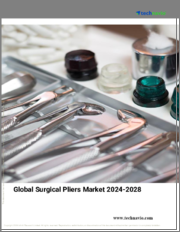
|
시장보고서
상품코드
1796132
수술용 플라이어 시장 규모, 점유율, 성장 분석 : 용도별, 디자인별, 유형별, 최종사용자별, 지역별 - 산업 예측(2025-2032년)Surgical Pliers Market Size, Share, and Growth Analysis, By Application (Clamping and Occluding, Dissecting and Cutting), By Design (Straight, Curved), By Type, By End User, By Region - Industry Forecast 2025-2032 |
||||||
세계의 수술용 플라이어 시장 규모는 2023년에 1억 4,520만 달러로 평가되며, 2024년 1억 5,173만 달러에서 2032년에는 2억 1,578만 달러로 성장하며, 예측 기간(2025-2032년)의 CAGR은 4.5%로 성장할 전망입니다.
세계의 수술용 플라이어 시장은 첨단 수술 툴에 대한 수요 증가로 인해 크게 성장하고 있습니다. 저침습 수술과 로봇 보조 수술의 보급은 혁신적인 수술 장비에 대한 투자를 촉진하고 있습니다. 수술 건수 증가, 인구의 고령화, 만성질환의 확산이 이러한 증가 추세를 더욱 부추기고 있습니다. 시장 확대에 기여하는 주요 요인으로는 인체공학적 디자인, 경량 소재, 멸균이 용이한 부품 채택 등을 꼽을 수 있습니다. 외과 의료 혁신의 강화는 수술용 플라이어 시장을 발전시키는 데 매우 중요합니다. 이 기구들은 정형외과, 심혈관외과, 치과 등 다양한 전문분야에서 필수적으로 사용되는 기구입니다. 의료 기관은 성능과 안전성을 향상시키기 위해 고품질 수술용 플라이어를 우선시하므로 업계는 지속적인 발전을 이룰 준비가 되어 있습니다.
목차
서론
- 조사의 목적
- 조사 범위
- 정의
조사 방법
- 정보 조달
- 2차와 1차 데이터 방법
- 시장 규모 예측
- 시장의 전제조건과 제한
개요
- 세계 시장 전망
- 공급과 수요 동향 분석
- 부문별 기회 분석
시장 역학과 전망
- 시장 개요
- 시장 규모
- 시장 역학
- 촉진요인과 기회
- 억제요인과 과제
- Porter의 산업 분석
주요 시장 인사이트
- 주요 성공 요인
- 경쟁의 정도
- 주요 투자 기회
- 시장 에코시스템
- 시장의 매력 지수(2024년)
- PESTEL 분석
- 거시경제 지표
- 밸류체인 분석
- 가격 분석
- 사례 연구
- 고객 구매 행동 분석
수술용 플라이어 시장 규모 : 용도별 & CAGR(2025-2032)
- 시장 개요
- 클램프와 폐색
- 해부와 절단
- Holding and Grasping
- 기타 용도
수술용 플라이어 시장 규모 : 디자인별 & CAGR(2025-2032)
- 시장 개요
- 스트레이트
- 커브
- 기타 디자인
수술용 플라이어 시장 규모 : 유형별 & CAGR(2025-2032)
- 시장 개요
- 일회용
- 재사용 가능
수술용 플라이어 시장 규모 : 최종사용자별 & CAGR(2025-2032)
- 시장 개요
- 병원과 진료소
- 외래 수술 센터
- 기타 최종사용자
수술용 플라이어 시장 규모 & CAGR(2025-2032)
- 북미
- 미국
- 캐나다
- 유럽
- 독일
- 스페인
- 프랑스
- 영국
- 이탈리아
- 기타 유럽 지역
- 아시아태평양
- 중국
- 인도
- 일본
- 한국
- 기타 아시아태평양
- 라틴아메리카
- 브라질
- 기타 라틴아메리카 지역
- 중동 및 아프리카
- GCC 국가
- 남아프리카공화국
- 기타 중동 및 아프리카
경쟁 정보
- 상위 5사의 비교
- 주요 기업의 시장 포지셔닝(2024년)
- 주요 시장 기업이 채택한 전략
- 최근 시장 동향
- 기업의 시장 점유율 분석(2024년)
- 주요 기업의 기업 개요
- 기업의 상세
- 제품 포트폴리오 분석
- 기업의 부문별 점유율 분석
- 매출의 전년대비 비교(2022-2024년)
주요 기업 개요
- BlackSmith Surgical
- Eurotek Surgical Co.
- Johnson & Johnson
- Integra LifeSciences Corporation
- KARL STORZ SE & Co. KG
- Novo Surgical Inc.
- Sklar Surgical Instruments
- Vital Surgical Technologies Inc.
- B. Braun Melsungen AG
- Stryker Corporation
결론과 제안
KSA 25.08.29Global Surgical Pliers Market size was valued at USD 145.2 million in 2023 and is poised to grow from USD 151.73 million in 2024 to USD 215.78 million by 2032, growing at a CAGR of 4.5% during the forecast period (2025-2032).
The global market for surgical pliers is experiencing significant growth driven by rising demand for advanced surgical instruments. The proliferation of minimally invasive and robotic-assisted surgeries is fueling investments in innovative surgical tools. The increasing volume of surgical procedures, an aging population, and the prevalence of chronic diseases further support this upward trend. Key factors contributing to market expansion include the adoption of ergonomic designs, lightweight materials, and components that facilitate easy sterilization. Enhanced surgical care innovations are pivotal in propelling the surgical pliers market forward. These instruments are essential across various specialties, including orthopedic, cardiovascular, and dental surgery. As healthcare institutions prioritize high-quality surgical pliers for improved performance and safety, the industry is poised for continued advancement.
Top-down and bottom-up approaches were used to estimate and validate the size of the Global Surgical Pliers market and to estimate the size of various other dependent submarkets. The research methodology used to estimate the market size includes the following details: The key players in the market were identified through secondary research, and their market shares in the respective regions were determined through primary and secondary research. This entire procedure includes the study of the annual and financial reports of the top market players and extensive interviews for key insights from industry leaders such as CEOs, VPs, directors, and marketing executives. All percentage shares split, and breakdowns were determined using secondary sources and verified through Primary sources. All possible parameters that affect the markets covered in this research study have been accounted for, viewed in extensive detail, verified through primary research, and analyzed to get the final quantitative and qualitative data.
Global Surgical Pliers Market Segments Analysis
Global Surgical Pliers Market is segmented by Application, Design, Type, End User and region. Based on Application, the market is segmented into Clamping and Occluding, Dissecting and Cutting, Holding and Grasping and Other Applications. Based on Design, the market is segmented into Straight, Curved and Other Designs. Based on Type, the market is segmented into Disposable and Reusable. Based on End User, the market is segmented into Hospitals and Clinics, Ambulatory Surgical Centers and Other End Users. Based on region, the market is segmented into North America, Europe, Asia Pacific, Latin America and Middle East & Africa.
Driver of the Global Surgical Pliers Market
The rising prevalence of chronic diseases, along with an aging population and enhanced access to healthcare, is leading to a surge in surgical procedures across various medical fields, including orthopedics, cardiology, and dentistry. As a result, there is a growing need for high-quality and reliable surgical tools, particularly surgical pliers. This heightened demand reflects the industry's focus on precision and patient safety, reinforcing the essential role that such instruments play in successful surgical outcomes. Consequently, the global surgical pliers market is poised for significant growth, driven by these compelling healthcare trends and the ongoing evolution of surgical practices.
Restraints in the Global Surgical Pliers Market
The high cost associated with high-quality reusable surgical pliers, which are often made from premium materials or equipped with advanced features, poses a significant challenge for their adoption. This financial barrier is particularly pronounced in low-income and underserved rural communities that operate under tight budget constraints. Consequently, the expense of these essential medical tools hinders access to effective surgical solutions, limiting their availability in areas that could greatly benefit from improved surgical care and technologies. The disparity in financial resources thus creates a restraint on the overall growth and utilization of surgical pliers in the market.
Market Trends of the Global Surgical Pliers Market
The Global Surgical Pliers market is witnessing a significant trend towards minimally invasive surgery (MIS) and outpatient care, which is transforming the design and functionality of surgical instruments. As healthcare providers prioritize quicker recovery times, reduced hospital stays, and cost-effectiveness, the demand for smaller, more precise, and ergonomically designed surgical pliers is surging. Innovations are focusing on enhanced dexterity, improved tip positioning, and streamlined shapes to facilitate their use in laparoscopic, dental, and robotic-assisted procedures. This trend highlights a growing preference for both high-precision reusable tools and disposable options, catering to evolving surgical practices and patient care models across developed markets.
Table of Contents
Introduction
- Objectives of the Study
- Scope of the Report
- Definitions
Research Methodology
- Information Procurement
- Secondary & Primary Data Methods
- Market Size Estimation
- Market Assumptions & Limitations
Executive Summary
- Global Market Outlook
- Supply & Demand Trend Analysis
- Segmental Opportunity Analysis
Market Dynamics & Outlook
- Market Overview
- Market Size
- Market Dynamics
- Drivers & Opportunities
- Restraints & Challenges
- Porters Analysis
- Competitive rivalry
- Threat of substitute
- Bargaining power of buyers
- Threat of new entrants
- Bargaining power of suppliers
Key Market Insights
- Key Success Factors
- Degree of Competition
- Top Investment Pockets
- Market Ecosystem
- Market Attractiveness Index, 2024
- PESTEL Analysis
- Macro-Economic Indicators
- Value Chain Analysis
- Pricing Analysis
- Case Studies
- Customer Buying Behavior Analysis
Global Surgical Pliers Market Size by Application & CAGR (2025-2032)
- Market Overview
- Clamping and Occluding
- Dissecting and Cutting
- Holding and Grasping
- Other Applications
Global Surgical Pliers Market Size by Design & CAGR (2025-2032)
- Market Overview
- Straight
- Curved
- Other Designs
Global Surgical Pliers Market Size by Type & CAGR (2025-2032)
- Market Overview
- Disposable
- Reusable
Global Surgical Pliers Market Size by End User & CAGR (2025-2032)
- Market Overview
- Hospitals and Clinics
- Ambulatory Surgical Centers
- Other End Users
Global Surgical Pliers Market Size & CAGR (2025-2032)
- North America (Application, Design, Type, End User)
- US
- Canada
- Europe (Application, Design, Type, End User)
- Germany
- Spain
- France
- UK
- Italy
- Rest of Europe
- Asia Pacific (Application, Design, Type, End User)
- China
- India
- Japan
- South Korea
- Rest of Asia-Pacific
- Latin America (Application, Design, Type, End User)
- Brazil
- Rest of Latin America
- Middle East & Africa (Application, Design, Type, End User)
- GCC Countries
- South Africa
- Rest of Middle East & Africa
Competitive Intelligence
- Top 5 Player Comparison
- Market Positioning of Key Players, 2024
- Strategies Adopted by Key Market Players
- Recent Developments in the Market
- Company Market Share Analysis, 2024
- Company Profiles of All Key Players
- Company Details
- Product Portfolio Analysis
- Company's Segmental Share Analysis
- Revenue Y-O-Y Comparison (2022-2024)
Key Company Profiles
- BlackSmith Surgical
- Company Overview
- Business Segment Overview
- Financial Updates
- Key Developments
- Eurotek Surgical Co.
- Company Overview
- Business Segment Overview
- Financial Updates
- Key Developments
- Johnson & Johnson
- Company Overview
- Business Segment Overview
- Financial Updates
- Key Developments
- Integra LifeSciences Corporation
- Company Overview
- Business Segment Overview
- Financial Updates
- Key Developments
- KARL STORZ SE & Co. KG
- Company Overview
- Business Segment Overview
- Financial Updates
- Key Developments
- Novo Surgical Inc.
- Company Overview
- Business Segment Overview
- Financial Updates
- Key Developments
- Sklar Surgical Instruments
- Company Overview
- Business Segment Overview
- Financial Updates
- Key Developments
- Vital Surgical Technologies Inc.
- Company Overview
- Business Segment Overview
- Financial Updates
- Key Developments
- B. Braun Melsungen AG
- Company Overview
- Business Segment Overview
- Financial Updates
- Key Developments
- Stryker Corporation
- Company Overview
- Business Segment Overview
- Financial Updates
- Key Developments












